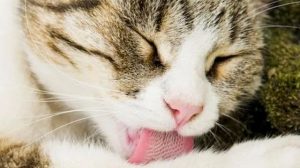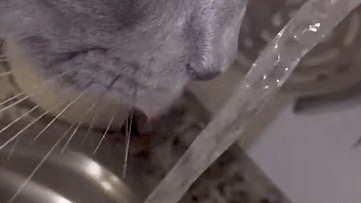When My Cat Licks Me, It’s a Sign of Love” – How many of you, fellow cat owners, have willingly embraced the “scraping” service from your feline friends because of this belief? The reason it feels like a scraping is because a cat’s tongue is covered with tiny, backward-facing barbs. These barbs, which are shaped like papillae, can be categorized into four types: filiform papillae, fungiform papillae, foliate papillae, and circumvallate papillae. Each of these plays a vital role on the cat’s tongue! Let’s dive into these fascinating details about your cat’s tongue.
-
Barbs? It’s Actually the Filiform Papillae!
In felines, the filiform papillae are highly keratinized, forming what we commonly refer to as “barbs.” These are spread across the entire surface of the tongue. The front part of the tongue has larger, rigid filiform papillae, while the area near the root features smaller, more flexible ones. For cats, these papillae don’t contain taste buds. Instead, they serve important functions, such as protecting the surface of the tongue, assisting in eating, and, most importantly, grooming. Under high-speed cameras, it’s observed that cats can groom themselves in just 0.25 seconds. The grooming process can be broken down into four stages: tongue extension → lateral expansion and hardening of the tongue tissue → the tongue sweeps across the surface → the tongue curls back into a U-shape. Additionally, the papillae at the tip of the cat’s tongue have tube-like cavities, which help the cat collect saliva to moisten their fur and can even help untangle matted fur by rotating the papillae.
-
Testing for Toxins with Fungiform Papillae
Fungiform papillae are located between the filiform papillae, mostly concentrated at the front of the tongue. Each of these papillae contains 1-3 taste buds at their tips. Cats primarily rely on these fungiform papillae to sense sour, bitter, salty, and umami tastes. The taste buds have openings called taste pores, which connect to the mouth and transmit the chemical signals from tastes to the brain. This allows our feline friends to savor their meals and reflect, “Oh, so this is what the meat I ate last night tasted like!” Although the number of fungiform papillae is relatively small, they are concentrated at the tip of the tongue. Scientists speculate that this location helps cats assess whether food is toxic (often bitter or sour) upon first contact, an adaptation to avoid potentially harmful substances in their evolutionary history.
-
Taste Detection with Vallate Papillae
Vallate papillae are symmetrically located on both sides of the tongue root. Like the fungiform papillae, the vallate papillae are covered with taste buds, but the taste buds are located on the sides of the papillae and have larger diameters than those found on the fungiform papillae.

-
Helping with Swallowing – Foliate Papillae
Foliate papillae are long, ridge-like structures that form distinct grooves and are located on the back sides of the tongue. To date, scientists haven’t found taste bud cells in the foliate papillae of cats, which means these papillae don’t have taste receptors (in contrast, humans have a rich concentration of taste buds in their foliate papillae). It’s likely that these papillae, like the filiform papillae, are primarily involved in swallowing and chewing motions.
-
The “Changing” Papillae
The marginal papillae of kittens gradually disappear as they grow. This type of papilla is present in many mammal infants, including pigs, dogs, whales, dolphins, and even humans. These papillae are found on the edges of the kitten’s tongue and come in various shapes, from simple triangles to leaf-like structures or even finger-like projections. For kittens, the marginal papillae help prevent milk from spilling out when they aren’t able to swallow immediately. As the kittens grow and wean off milk, they no longer need this support, and these papillae naturally degenerate and are replaced by the barbed filiform papillae. In addition to the disappearance of the marginal papillae, other types of papillae undergo changes as the cat ages, particularly influenced by changes in diet and chewing/swallowing habits. The size, shape, and number of the various papillae vary from cat to cat and are directly related to their dietary preferences. The papillae of kittens and adult cats differ in terms of hardness, size, and the distribution of taste buds. This dynamic change is likely caused by factors such as aging, dietary shifts, and accompanying changes in their chewing and swallowing behaviors. For zoologists, comparing the papillae differences among various animals provides valuable insights into their dietary health.
As a responsible cat owner, paying attention to changes in your cat’s tongue can reveal important health issues. A normal cat tongue should be a healthy, soft pink, indicating good oxygen levels in the blood. It should be free from ulcers, foreign objects, bad breath, or excessive drooling. If you notice any abnormalities with your cat’s tongue and are unsure of the cause, the best option is always to seek veterinary care.Does your cat lick you? Feel free to share in the comments below, post pictures, and let’s exchange cat care tips and stories!





